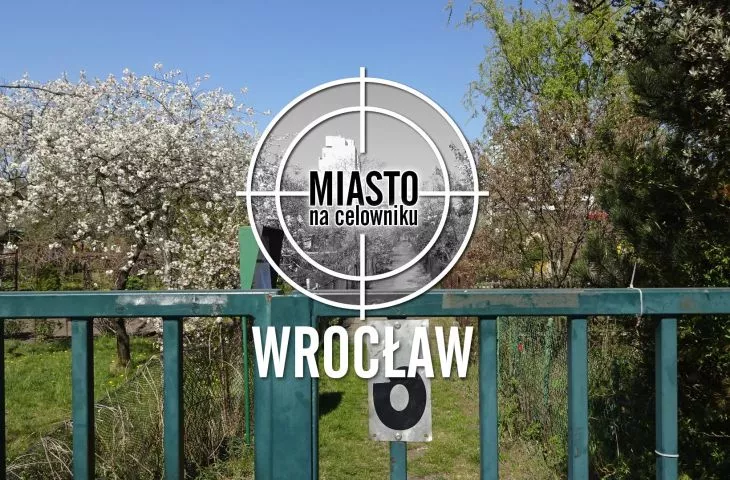On the one hand, allotment gardens are recreational areas for residents (although only a select few), on the other - often valuable land with access to public transportation. That's why in Wroclaw there are ideas to move the gardens from the center to another place - to the suburbs, and then partially build them up, or turn them into so-called allotment parks.
Allotment gardens, like in other German cities, with Berlin at the forefront, began to emerge in Breslau even before the war(Kleingarten). Today there are the largest number of them here in Poland, covering about 1,300 hectares. During the People's Republic of Poland, more gardens were created, often occupying all the vacant land, and the new development was concentrated in areas also built up before the war. It was only during the Third Republic, when land for development began to run out, that ideas were put forward to change the designation of some of it for investment.
The law makes it possible to change
Allotment gardens are often not owned by the Polish Allotment Association, but exist under the law in the use of this institution. Since 1990, to a large extent, allotment areas have belonged to municipalities, which, however, do not have full freedom to dispose of the space. In the past, the legislation gave the municipality virtually no opportunity to decide on the future of the allotments, which the Constitutional Court in 2012 found to be contrary to the municipality's constitutional right to property.
Allotment gardens in Olbin
Photo: Mateusz Kokoszkiewicz
Now for public purposes, gardens can be acquired through expropriation. In cases where the allotment holders have not paid for the land, but are using the land free of charge, the municipality has the right to use it for purposes other than public. However, it must provide replacement land and pay compensation for the outlay. The agreement must be agreed to by 2/3 of the allotment holders. If there were no such majority - the city can go to court.
plans for relocation
Some allotment gardens were also considered a reserve for development by Wroclaw planners. For years, Wroclaw's development plans had envisioned that the gardens would be built over, including: in Wroclaw's Olbin, between the Oder River and the densely built-up downtown - these areas were envisioned half for park greenery and half for development; on the corner of Borowska Street and al. Armii Krajowej, where residential development is envisaged, and in Stabłowice; along Wojanowska Street (ROD Malwa), where single-family houses are planned. Development studies (which are not directly binding, but which set the directions for the creation of plans) have additionally provided for development in, among others, Popowice on Starogroblowa Street or Muchobor Wielki, between industrial areas.
In some places the gardens have been partially eliminated due to public investments - for example, for the construction of the highway bypass of Wroclaw or, last year, during the construction of the streetcar line to Nowy Dwór. The allotment gardens were also replaced by office buildings in the vicinity of the Wroclaw Technology Park and a housing development near the railway station, in the very center of the city.
Olbin gardens
Source: Spatial Information System of Wroclaw
Allotment holders from Olbin protested against further designation of the gardens for development during the creation of the development study in 2018. They succeeded in winning that Ołbin should continue to be allotment areas... or other green areas, such as parks. Other areas of allotment gardens in the development study were designated for development.
Expansion: pros and cons
The debate over the future of development sites continues. A proponent of expansion on some (those closest to the center) gardens, linked to the relocation of allotments to the outskirts of the city, is Jakub Nowotarski, president of the association Action City, which deals with urban space and ecology, among other issues.
The garden areas are in places well connected by bicycle, on foot and by public transportation. It is in such places that new buildings should be built, and in fact this will be a necessity in the future. That's why it's worth planning this process over the years," Nowotarski says.
As the activist adds, if we do not take into account the development of areas in the center, then urban sprawl will proceed. The alternative is to expand in the suburbs where there is no technical infrastructure, schools, roads, for which we all have to pay. Therefore, it is better that it is the allotment gardens that are located in the suburbs," the chairman believes.
As Nowotarski adds: a good example are the allotment gardens along the under-construction streetcar route to Popowice, part of which could be developed, and the new residents could immediately use the streetcar, without burdening the city with more cars.
The activist stipulates that the entire change must occur in a process that would take into account the interests of allotment holders, other residents and the city.
Many of the plots are unused, so it could be a swap process spread over years, Nowotarski believes. In the event of a transfer, the city should obtain the consent of the allotment holders, pay appropriate compensation, and provide a replacement site where new gardens could be built, the AM president stresses.
Popowice gardens
Source: Spatial Information System of Wroclaw
An opponent of the relocation of the allotment gardens is Pawel Pomian, an activist of the Green party and the Eco-Unionassociation, and a neighborhood councilor of Gajowice:
I agree with the designation of part of the gardens for necessary transportation investments, but not for development. Allotment gardens are a green, recreational area, needed by residents.
Pomian is also not convinced by the argument that the gardens could be located in other places, outside the center.
They are often used by elderly people who want a green area right next to their homes, and getting to far parts of the city would be a hindrance, Pomian says.
Allotment gardens in Olbin
photo: Mateusz Kokoszkiewicz
Allotments: for residents or for everyone?
Another problem highlighted by the environmentalist is that allotment gardeners often fence off their land and it is difficult to cross, which creates problems for pedestrians and cyclists. As a result of fencing, they become non-public and needed green spaces, and obstacles for citizens. This, however, can be changed.
As Pomian says: At our place in Gajowice the alleys are being opened up, and together with the city office the allotment holders have made an effort to renovate the pavement. Such cooperation between the city and the allotment association is very useful.
The Bender Society, meanwhile, in 2015 proposed the introduction of a category of so-called allotment park, which would connect private allotments with park areas.
Allotment gardens cannot be closed cities within a city. An allotment park is an area that contains a maximum of 70 percent of allotment gardens, which are also accompanied by playgrounds, green spaces and open areas, possibly 10 percent of low-rise buildings, such as services, and is open to residents. Some of the current allotment gardens should be turned into park areas, and some, such as in the Downtown area, can be replaced with new buildings to fill in the gaps in development, TB activists wrote.
Allotment gardens in Olbin
photo: Mateusz Kokoszkiewicz
Allotment gardens are a form of leisure needed by citizens. Surely, however, a deep discussion among urban planners, allotment holders and residents needs to be held on where they should be located and whether some garden areas in the center could not be designated for development, or for public parks. Green space is important, but there is definitely a greater need for green space that is accessible to everyone: parks and green spaces. Development in the centers is also needed to prevent urban sprawl and promote confusion where it is easy to travel by foot or bicycle.


































